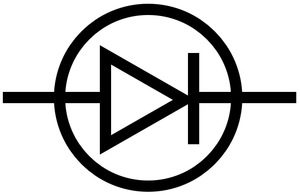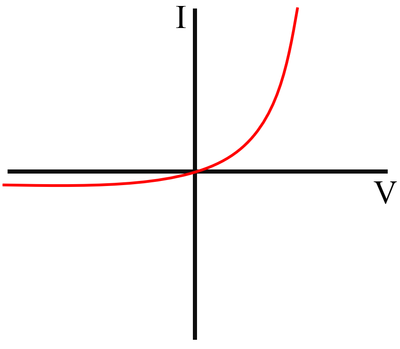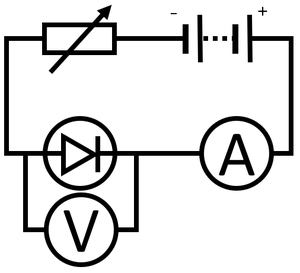Difference between revisions of "Diode"
| (5 intermediate revisions by 2 users not shown) | |||
| Line 8: | Line 8: | ||
: [[Diode]]s can be used to change an [[Alternating Current|alternating current]] into a [[Direct Current|direct current]]. | : [[Diode]]s can be used to change an [[Alternating Current|alternating current]] into a [[Direct Current|direct current]]. | ||
| + | ===IV Graph=== | ||
{| class="wikitable" | {| class="wikitable" | ||
|[[File:IVGraphDiode.png|center|400px]] | |[[File:IVGraphDiode.png|center|400px]] | ||
| Line 13: | Line 14: | ||
====Description==== | ====Description==== | ||
| − | The | + | The [[IV Graph]] for a [[diode]] shows that: |
*For a positive [[Potential Difference|potential difference]] the [[Electrical Current|current]] increases rapidly with an increase in [[Potential Difference|potential difference]] | *For a positive [[Potential Difference|potential difference]] the [[Electrical Current|current]] increases rapidly with an increase in [[Potential Difference|potential difference]] | ||
*For a negative [[Potential Difference|potential difference]] the [[Electrical Current|current]] remains negligible and does not increase as the [[Potential Difference|potential difference]] becomes larger. | *For a negative [[Potential Difference|potential difference]] the [[Electrical Current|current]] remains negligible and does not increase as the [[Potential Difference|potential difference]] becomes larger. | ||
| + | |||
| + | ====Explanation==== | ||
| + | : The [[Electrical Resistance|resistance]] of a [[diode]] is very low for [[Electrical Current|current]] in the forward direction and very high in the back direction. | ||
| + | |||
| + | ====Obtaining the IV Graph==== | ||
| + | {| class="wikitable" | ||
| + | |- | ||
| + | |[[File:DiodeIVGraphCircuit.png|center|300px]] | ||
| + | | style="height:20px; width:300px; text-align:left;" | | ||
| + | #Connect an [[ammeter]] in [[Series Circuit|series]] with the [[diode]] to measure [[Electrical Current|current]] through the [[diode]]. | ||
| + | #Connect a [[voltmeter]] in [[Parallel Circuit|parallel]] with the [[diode]] to measure the [[Potential Difference|potential difference]] across it. | ||
| + | #Use a [[Variable Resistor|variable resistor]] in [[Series Circuit|series]] with the [[diode]] to vary the [[Potential Difference|potential difference]] across the [[diode]]. | ||
| + | #Start with a [[Potential Difference|potential difference]] of zero and increase the [[Potential Difference|potential difference]] by an interval of 0.2V up to 2V. | ||
| + | #Recording the reading on the [[voltmeter]] and [[ammeter]]. | ||
| + | #Reverse the connections on the [[battery]] and repeat steps 4 and 5 to find the I-V relationship for negative [[Potential Difference|potential difference]] and [[Electrical Current|current]]. | ||
| + | |} | ||
| + | |||
| + | ===References=== | ||
| + | ====AQA==== | ||
| + | |||
| + | :[https://www.amazon.co.uk/gp/product/0008158770/ref=as_li_tl?ie=UTF8&camp=1634&creative=6738&creativeASIN=0008158770&linkCode=as2&tag=nrjc-21&linkId=ec31595e720e1529e49876c3866fff6e ''Diode, pages 52-3, 65, GCSE Physics; Student Book, Collins, AQA ''] | ||
| + | :[https://www.amazon.co.uk/gp/product/1471851370/ref=as_li_tl?ie=UTF8&camp=1634&creative=6738&creativeASIN=1471851370&linkCode=as2&tag=nrjc-21&linkId=01c69b0ae058f809cf636033e6ba793e ''Diodes, page 43, GCSE Physics, Hodder, AQA ''] | ||
| + | :[https://www.amazon.co.uk/gp/product/1782945598/ref=as_li_tl?ie=UTF8&camp=1634&creative=6738&creativeASIN=1782945598&linkCode=as2&tag=nrjc-21&linkId=ad276ad49df77ab4b40ab4fd0fe09847 ''Diodes, pages 180, 181, 183, GCSE Combined Science; The Revision Guide, CGP, AQA ''] | ||
| + | :[https://www.amazon.co.uk/gp/product/178294558X/ref=as_li_tl?ie=UTF8&camp=1634&creative=6738&creativeASIN=178294558X&linkCode=as2&tag=nrjc-21&linkId=f0dfb66dafcb0c6e9449e7b1a4ae1ac91 ''Diodes, pages 24, 26, GCSE Physics; The Revision Guide, CGP, AQA ''] | ||
| + | :[https://www.amazon.co.uk/gp/product/1471851354/ref=as_li_tl?ie=UTF8&camp=1634&creative=6738&creativeASIN=1471851354&linkCode=as2&tag=nrjc-21&linkId=9012a0d354024419214fb3ad5ac44ba0 ''Diodes, pages 293, 298, GCSE Combined Science Trilogy 1, Hodder, AQA ''] | ||
| + | :[https://www.amazon.co.uk/gp/product/019835939X/ref=as_li_tl?ie=UTF8&camp=1634&creative=6738&creativeASIN=019835939X&linkCode=as2&tag=nrjc-21&linkId=57e96876985fc39b1a3d8a3e3dc238b6 ''Diodes, pages 52-53, 57, GCSE Physics; Third Edition, Oxford University Press, AQA ''] | ||
| + | :[https://www.amazon.co.uk/gp/product/1782946403/ref=as_li_tl?ie=UTF8&camp=1634&creative=6738&creativeASIN=1782946403&linkCode=as2&tag=nrjc-21&linkId=32a0abb60dff015b15b50e9b1d7b4644 ''Diodes, pages 60, 66, GCSE Combined Science Trilogy; Physics, CGP, AQA ''] | ||
| + | :[https://www.amazon.co.uk/gp/product/1782945970/ref=as_li_tl?ie=UTF8&camp=1634&creative=6738&creativeASIN=1782945970&linkCode=as2&tag=nrjc-21&linkId=a120d24dcc7cc7a58192069a3aafc1d2 ''Diodes, pages 62, 68, GCSE Physics; The Complete 9-1 Course for AQA, CGP, AQA ''] | ||
| + | :[https://www.amazon.co.uk/gp/product/1471851370/ref=as_li_tl?ie=UTF8&camp=1634&creative=6738&creativeASIN=1471851370&linkCode=as2&tag=nrjc-21&linkId=01c69b0ae058f809cf636033e6ba793e ''Diodes; circuit symbol, page 38, GCSE Physics, Hodder, AQA ''] | ||
| + | |||
| + | ====Edexcel==== | ||
| + | |||
| + | :[https://www.amazon.co.uk/gp/product/1292120223/ref=as_li_tl?ie=UTF8&camp=1634&creative=6738&creativeASIN=1292120223&linkCode=as2&tag=nrjc-21&linkId=068ecf40278c32406a7f1c6e66751417 ''Diodes, page 148, GCSE Physics, Pearson Edexcel ''] | ||
| + | :[https://www.amazon.co.uk/gp/product/1782948163/ref=as_li_tl?ie=UTF8&camp=1634&creative=6738&creativeASIN=1782948163&linkCode=as2&tag=nrjc-21&linkId=0fdbfd5dd397d6e24a9dfb250f08587f ''Diodes, page 229, GCSE Physics, CGP, Edexcel ''] | ||
| + | :[https://www.amazon.co.uk/gp/product/1292120193/ref=as_li_tl?ie=UTF8&camp=1634&creative=6738&creativeASIN=1292120193&linkCode=as2&tag=nrjc-21&linkId=572df39392fb4200db8391d98ae6314e ''Diodes, page 388, GCSE Combined Science, Pearson Edexcel ''] | ||
| + | |||
| + | ====OCR==== | ||
| + | :[https://www.amazon.co.uk/gp/product/0198359837/ref=as_li_tl?ie=UTF8&camp=1634&creative=6738&creativeASIN=0198359837&linkCode=as2&tag=nrjc-21&linkId=3c4229e8b023b2b60768e7ea2307cc6f ''Diodes, pages 107, Gateway GCSE Physics, Oxford, OCR ''] | ||
| + | :[https://www.amazon.co.uk/gp/product/1782945695/ref=as_li_tl?ie=UTF8&camp=1634&creative=6738&creativeASIN=1782945695&linkCode=as2&tag=nrjc-21&linkId=ceafcc80bcad6b6754ee97a0c7ceea53 ''Diodes, pages 176, 179, Gateway GCSE Combined Science; The Revision Guide, CGP, OCR ''] | ||
| + | :[https://www.amazon.co.uk/gp/product/1782945687/ref=as_li_tl?ie=UTF8&camp=1634&creative=6738&creativeASIN=1782945687&linkCode=as2&tag=nrjc-21&linkId=9a598e52189317a20311d7a632747bc9 ''Diodes, pages 45-47, Gateway GCSE Physics; The Revision Guide, CGP, OCR ''] | ||
Latest revision as of 15:40, 4 December 2019
Contents
Key Stage 4
Meaning
A diode is an electrical component which only allows electricity through in one direction.
About Diodes
- Diodes have a low resistance in one direction but a very high resistance in the reverse direction.
- Diodes can be used to change an alternating current into a direct current.
IV Graph
Description
The IV Graph for a diode shows that:
- For a positive potential difference the current increases rapidly with an increase in potential difference
- For a negative potential difference the current remains negligible and does not increase as the potential difference becomes larger.
Explanation
- The resistance of a diode is very low for current in the forward direction and very high in the back direction.
Obtaining the IV Graph
|
References
AQA
- Diode, pages 52-3, 65, GCSE Physics; Student Book, Collins, AQA
- Diodes, page 43, GCSE Physics, Hodder, AQA
- Diodes, pages 180, 181, 183, GCSE Combined Science; The Revision Guide, CGP, AQA
- Diodes, pages 24, 26, GCSE Physics; The Revision Guide, CGP, AQA
- Diodes, pages 293, 298, GCSE Combined Science Trilogy 1, Hodder, AQA
- Diodes, pages 52-53, 57, GCSE Physics; Third Edition, Oxford University Press, AQA
- Diodes, pages 60, 66, GCSE Combined Science Trilogy; Physics, CGP, AQA
- Diodes, pages 62, 68, GCSE Physics; The Complete 9-1 Course for AQA, CGP, AQA
- Diodes; circuit symbol, page 38, GCSE Physics, Hodder, AQA
Edexcel
- Diodes, page 148, GCSE Physics, Pearson Edexcel
- Diodes, page 229, GCSE Physics, CGP, Edexcel
- Diodes, page 388, GCSE Combined Science, Pearson Edexcel


